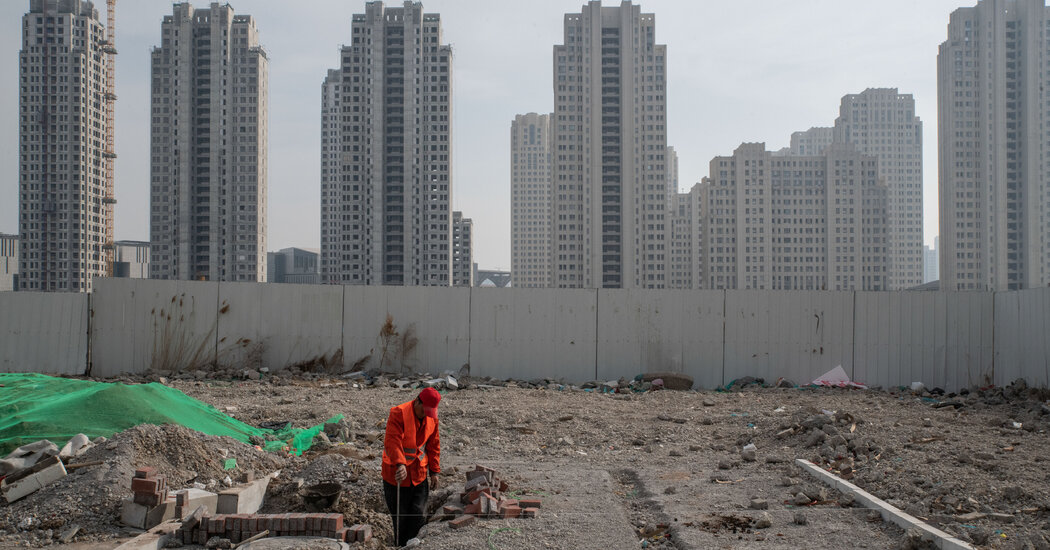As China’s cities grow, they are also sinking.
An estimated 16 percent of the country’s major cities are losing more than 10 millimeters of elevation per year and nearly half are losing more than 3 millimeters per year, according to a new study published in the journal Science.
These amounts may seem small, but they accumulate quickly. In 100 years, a quarter of China’s urban coastal land could sit below sea level because of a combination of subsidence and sea level rise, according to the study.
“It’s a national problem,” said Robert Nicholls, a climate scientist and civil engineer at the University of East Anglia who reviewed the paper. Dr. Nicholls added that, to his knowledge, this study is the first to measure subsidence across many urban areas at once using state-of-the-art radar data from satellites.
Subsidence in these cities is caused in part by the sheer weight of buildings and infrastructure, the study found. Pumping water from aquifers underneath the cities also plays a role, as do oil drilling and coal mining, all activities that leave empty space underground where soil and rocks can compact or collapse.
Beijing is among the places in the country sinking the fastest. So is nearby Tianjin, where last year thousands of residents were evacuated from high-rise apartment buildings after the streets outside suddenly split apart. Within these cities, sinking is uneven. When pieces of land next to each other subside at different rates, whatever is built on top of that land is at risk of damage.
Other countries, including the United States, have similar problems.
“Land subsidence is an overlooked problem that almost exists everywhere,” said Manoochehr Shirzaei, a geophysicist at Virginia Tech who has studied subsidence in American coastal cities using similar methods. Dr. Shirzaei also reviewed the new study on Chinese cities by Zurui Ao of South China Normal University, Xiaomei Hu and Shengli Tao of Peking University, and their colleagues.
“I believe the majority of the adaptation strategies that we have, and resiliency plans to combat climate change, are inaccurate, just because they did not include land subsidence,” he said. “It hasn’t been studied the way, for example, sea level rise has been studied.”
The new study was based on satellite radar measurements of how much the ground surface in 82 major cities, accounting for three-quarters of China’s urban population, moved up or down between 2015 and 2022. The researchers compared these measurements to data on potential contributing factors, like the weight of buildings in these cities and changing groundwater levels underneath them.
The researchers also combined their subsidence measurements with projections of sea level rise to figure out which cities might end up below sea level. One caveat with these findings is that they assumed a constant rate of subsidence over the next 100 years, but these rates can change along with human activity.
About 6 percent of land in China’s coastal cities currently has a relative elevation below sea level. If the global average sea level rises by 0.87 meters, or a little less than 3 feet, by 2120 (the higher of two commonly used scenarios considered by the researchers) that proportion could rise to 26 percent, this study found.
Being below sea level doesn’t mean a city is automatically doomed. Much of the Netherlands is below sea level and sinking, but the country has been extensively engineered to prevent flooding in places and to accommodate it in others.
The key to minimizing damage is limiting groundwater extraction, the researchers wrote. Shanghai is already taking this approach and is sinking more slowly than other Chinese cities. In Japan, groundwater management over the years has proved successful at stabilizing subsidence in Tokyo and Osaka.
Some places are even combating subsidence by injecting water into depleted aquifers in a process called managed recharge.
It’s difficult to stop subsidence entirely, Dr. Nicholls said. “You’ve got to live with what’s left.” Mainly, he said, this means adapting to sea level rise in coastal areas; not just the sea level rise caused by climate change, but also the effects of sinking land.
